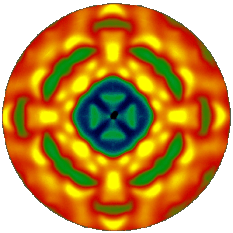Diffuse X-Ray Scattering
X-rays are electromagnetic waves with very short wavelengths, comparable to the radii of interatomic distances. Therefore, they are suitable to study matter on atomic length scales. This is what the field of x-ray scattering in all its variety is about, and I am not even trying to give an overview here.
If you are not familiar with this at all, you may want to look up Bragg's law, which is at the heart of x-ray diffraction - scattering at regular periodic structures such as crystalline materials. Very similar to an optical grating for visible light, the atom lattice generates sharp reflections for x-rays of particular wavelength and angle of incidence. This is how we learnt about the atomic structure of matter itself. If you want to know more, there are much better sources to read on it elsewhere.
 However, in addition to the sharp reflections caused by the periodic lattice one can observe a much weaker diffuse scattering for all other angles. This scattering is generated by all non-periodic perturbations of the lattice, for example local distortions, irregular configuration of the atom species in an alloy, vacancies, other defects and thermal vibrations. The picture on the left shows the diffuse scattering pattern of a titanium-vanadium alloy at room temperature. It is not as straightforward to interpret as Bragg reflections, but it contains a lot of information on any kind of non-periodic correlations in the the crystal.
However, in addition to the sharp reflections caused by the periodic lattice one can observe a much weaker diffuse scattering for all other angles. This scattering is generated by all non-periodic perturbations of the lattice, for example local distortions, irregular configuration of the atom species in an alloy, vacancies, other defects and thermal vibrations. The picture on the left shows the diffuse scattering pattern of a titanium-vanadium alloy at room temperature. It is not as straightforward to interpret as Bragg reflections, but it contains a lot of information on any kind of non-periodic correlations in the the crystal.
 My main interest at the time was, how differently sized atoms forming an alloy distort the lattice around them and what kind of interactions this induces. In fact, the strain field of a single atom can reach out ten or even twenty lattice sites and affect the mechanical properties of the material, e.g. how hard or soft, how tough or brittle it is. More than that, the strain field of one atom can influence the chance to accomodate another one of its kind in its vicinty. Ultimately, it can decide (in addition to the electronic interactions), whether and how well two kind of atoms mix.
My main interest at the time was, how differently sized atoms forming an alloy distort the lattice around them and what kind of interactions this induces. In fact, the strain field of a single atom can reach out ten or even twenty lattice sites and affect the mechanical properties of the material, e.g. how hard or soft, how tough or brittle it is. More than that, the strain field of one atom can influence the chance to accomodate another one of its kind in its vicinty. Ultimately, it can decide (in addition to the electronic interactions), whether and how well two kind of atoms mix.
I conducted the experiments for this project at the European Synchrotron Radiation Source (ESRF) in Grenoble (France). This is a storage ring that keeps electrons very close to the speed of light on a circular path. Each time when they are forced to change their flight direction they emit a shower of x-rays that can be used for experiments. We used unusual short wavelengths, corresponding to x-rays with very high energies.
Text and figures (c) Ingo Ramsteiner
Ingo Ramsteiner
High-Energy X-Ray Study of Short Range Order and Phase Transformations in Titanium-Vanadium
Dissertation, Max-Planck-Institut für Metallforschung, Universität Stuttgart (2005)
H. Reichert, A. Schöps, I.B. Ramsteiner, V.N. Bugaev, O.Shchyglo, A. Udyansky, H. Dosch, M. Asta, R. Drautz, V. Honkimäki:
Competition between order and phase separation in Au-Ni,
Phys.Rev.Lett. 95 (23) 235703 (2005)
I.B. Ramsteiner, A. Schöps, H. Reichert, H. Dosch, V. Honkimäki, Z. Zhong and J. B. Hastings
High-Energy X-Ray Diffuse Scattering
J.Appl.Cryst. 42, 392-400 (2009)
The work described here was done at the Max-Planck-Institut für Metallforschung in Stuttgart in group of Prof. Helmut Dosch. The experiments have been performed at beamline ID15 at ESRF in Grenoble.